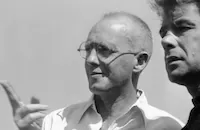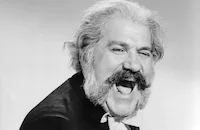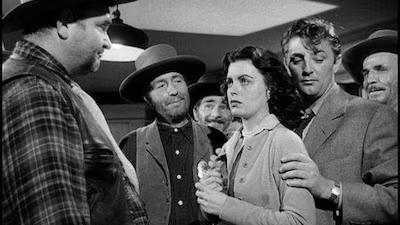Where Danger Lives

Brief Synopsis
Cast & Crew
John Farrow
Robert Mitchum
Faith Domergue
Claude Rains
Maureen O'sullivan
Charles Kemper
Film Details
Technical Specs

Synopsis
During his late-night shift at a San Francisco hospital, Dr. Jeff Cameron is called to attend a beautiful, unidentified woman who has attempted suicide. When the woman finally comes to, she sees the white rose that Jeff had ordered for his fiancée, nurse Julie Dorn, and assumes it is for her. Later, Jeff learns that the woman, Margo, discharged herself after giving a phony last name, but has wired him to come see her that night. At her seacliff home, Margo tells the concerned Jeff that she attempted suicide because she was feeling lonely after the death of her mother. Margo also states that her father, Frederick Lannington, is in Canada and that, because of his social position, she fears scandalous publicity. Attracted to his seductive patient, Jeff agrees not to notify the police about her suicide attempt and breaks a date with Julie. After a brief but intense courtship, Jeff and Margo find themselves deeply in love, but Margo shocks Jeff one evening when she announces that she is soon leaving for Nassau with her disapproving father. Although Margo promises Jeff she will try to change her father's mind, Jeff becomes anxious and goes to confront Lannington at his house. There, he is stunned to learn that the middle-aged Lannington is not Margo's father, but her husband. Lannington also reveals that Jeff is not Margo's first lover and alludes to the difficulties he has had living with his unloving wife. Disgusted by Margo's deceit, Jeff walks out of the house, but rushes back when he hears her screaming. Seeing Margo's bloodied ear, Jeff is about to take her away when an enraged Lannington starts to beat him over the head with a poker. After Jeff knocks the crazed Lannington out, he goes to the bathroom to tend to his wounds. The woosy Jeff then discovers that Lannington is dead, and although his first impulse is to call the police, Margo convinces him to flee with her to Nassau. At the airport, however, the couple see two policemen talking to the ticket agent and leave in a panic. While driving toward Mexico, the still dazed Jeff realizes that he has suffered a concussion and tells Margo that he will probably fall into a coma within forty-eight hours. Later, after trading Margo's expensive convertible for a rundown truck, Jeff crashes into a truck in an Arizona desert town. Anxious to depart undetected, Jeff uses most of his cash to bribe the drunken driver, and the couple speeds out of town just as radio reports announce Lannington's murder. That night, they are detained in Postville, another Arizona town, for violating the rules of "Whiskers Week," a celebration in which everyone must sport beards and dress in western costumes. Faced with a twenty-five dollar fine, Margo tells the intoxicated townsmen that she and Jeff are planning to marry. The townspeople then insist that the couple "get hitched" that night and cajole them into staying in town. In their "honeymoon suite," Margo, who has been preventing Jeff from listening to the radio, secretly listens to it herself and becomes angry when the announcer mentions the psychiatric treatment she underwent. Later, after Margo and Jeff have fled town, the sheriff realizes who the newlyweds are and notifies the border patrol, who inform him that Lannington was smothered to death. To avoid the border patrol, Margo pawns an expensive bracelet and buys illegal transportation into Mexico. While waiting in a cheap hotel for their van, Margo reveals to Jeff, whose hand and side have become numb from a progressive paralysis, that for years she has been stashing Lannington's money in a Mexico bank. Shocked by this confession, Jeff tells Margo that he cannot go to Mexico with her. Margo rails against Jeff, who finally deduces her insanity and tells her that he has only pity for her. An enraged Margo smothers the now-unconscious Jeff with a pillow and then boards the Mexico-bound van. When Margo sees Jeff staggering toward the stopped van, she shoots him in a terrified rage and is then shot by the border police. Before she dies, Margo proudly confesses to her husband's murder. Later, in a hospital, a recovering Jeff is about to send a white rose to Julie when she appears at his bedside.

Director

John Farrow
Cast

Robert Mitchum

Faith Domergue

Claude Rains

Maureen O'sullivan

Charles Kemper
Ralph Dumke
Billy House
Harry Shannon
Philip Van Zandt

Jack Kelly
Lillian West
Ruth Lewis
Julia Faye
Dorothy Abbott
Gaylord Pendleton
Joey Ray
Jerry James
Carl Saxe
Marvin Jones
Art Dupuis
Stanley Andrews

Jack Kruschen

Elaine Riley
Gordon Clark

Geraldine Wall
David Stollery
Sherry Jackson
Clifford Brooke
Jim Dundee
Tol Avery

Robert R. Stevenson
Gene Barnes

Ray Teal
Lester Dorr
Duke York
Earle Hodgins
Marie Allison
Betty Hannon
Grace Macnaughton
Julian Rivero
George Sherwood
John Sheehan
Len Hendry
Don House
James Brick Sullivan
Mike Lally
Carlos Albert
Philip Ahlm
Tina Menard
Erno Verebes
Allen Mathews
Florence Hamblin
Amilda Cuddy
Maxine Gates
Phil Boutelje
Frank Leyva
Herschel Daugherty
Linda Johnson
Gerry Ganzer
Marie Thomas
Bobby Coleman
Helen Brown
William E. Green
Ann Zika
Ethan Laidlaw
William Bailey
Stuart Holmes
Carl Sklover
Jeraldine Jordan
Hazel Boyne
Crew
Irwin Allen
Irwin Allen
C. Bakaleinikoff
Charles Beckett
Charles Bennett
Ralph Berger
Mel Berns
Layne Britton
Charles Burke
Tom Clement
Irving Cooper
Irving Cummings Jr.
Irving Cummings Jr.
Albert S. D'agostino
Eddie Donahoe
John Farrow
Larry Germain
Gale Mcgarry
Nicholas Musuraca
Clem Portman
Leo Rosten
Samuel Ruman
Darrell Silvera
John Sturtevant
John Tribby
Eda Warren
Roy Webb
Michael Woulfe

Photo Collections
Videos
Movie Clip




Trailer
Hosted Intro
Film Details
Technical Specs

Articles
Where Danger Lives
Instead of an ordinary insurance salesman, mechanic or detective, Jeff Cameron (Mitchum) is a gifted surgeon, and his temptress, Margo Lannington (Faith Domergue), is not merely diabolical but certifiably, medically insane. Unfortunately, the deed is done before Mr. Lannington (Claude Rains) can share this crucial fact with his wife's would-be lover. The fugitive couple's turbulent rush to the Mexican border is complicated by outlandish twists of fate more reminiscent of a playful Hitchcock film than a gritty crime thriller. In one bit of inspired irony, the couple is taken into custody during their flight not because of the widespread APBs, but because Cameron doesn't have enough whiskers on his face (during a small town's "Pioneer Days" celebration). This spirit of orchestrated suspense is no doubt the contribution of screenwriter Charles Bennett, who also penned the scripts for Hitchcock's The Man Who Knew Too Much (1934), The Thirty-Nine Steps (1935) and Foreign Correspondent (1940).
Mitchum's trademark as an actor was his lazy nonchalance, maintaining an easy coolness even in the midst of emotional turmoil. In Where Danger Lives, this quality is played to a delicious extreme, as Dr. Cameron has a few too many Polynesian cocktails in one scene, takes a beating with a fireplace poker in another, and spends the remainder of the film growing increasingly weary. By film's end, Mitchum is audaciously performing his most dramatic scenes while lying semi-conscious on the floor (and clearly loving every minute of it).
Domergue did her best to fill the histrionic void as the manipulative, deranged Margo. The actress was the highly touted discovery of RKO head Howard Hughes, who had intended to debut her talents in an extravagant costume drama, Vendetta (1950). But as that film became plagued with complications and creative differences, Hughes wisely opted instead for Where Danger Lives, a film that was more modest in scale, but far superior in delivering the brand of romance and thrills that audiences of 1950 hungered for.
Director: John Farrow
Producer: Irwin Allen, Irving Cummings Jr.
Screenplay: Charles Bennett, Leo Rosen (story)
Cinematography: Nicholas Musuraca
Editor: Eda Warren
Art Direction: Ralph Berger, Albert S. D'Agostino
Music: Roy Webb
Cast: Robert Mitchum (Jeff Cameron), Faith Domergue (Margo Lannington), Claude Rains (Frederick Lannington), Maureen O'Sullivan (Julie), Charles Kemper (Police Chief)
BW-81m. Closed Captioning.
by Bret Wood

Where Danger Lives
TCM Remembers - Jack Kruschen
Jack Kruschen (1922-2002)
He may have not been a household name, yet his career consisted of over seventy-five films, spanned over six decades, and displayed a strong versatility in playing either dramatic or comic roles with equal effectiveness. He was the definitive, "I can't quite remember the name, but I remember the face" character player who enlivened many films with his robust frame, cherubic face and infectious smile. His name was Jack Kruschen, a superb performer who died on April 2, 2002 at the age of 80, leaving behind a strong body of work that was impressive as any character actor of his generation.
Kruschen was born on March 20, 1922 in Winnipeg, Manitoba, Canada. The son of a watchmaker who later set up shop in Hollywood, he was performing in an operetta at Hollywood high school when a talent scout for CBS radio discovered him. Kruschen was soon doing voice characterizations on popular network programs such as Dragnet, The Danny Thomas Show and Sam Spade. With his gift for dialects (he was most adept at playing ethnic types like Greeks, Yiddish or Italians - a skill finely honed in his radio days), Kruschen was a natural for the movies and soon made his film debut with a small role in the Betty Hutton comedy Red, Hot and Blue (1949).
Kruschen's early career is peppered with a variety of roles like a comical gangster in both Abbott & Costello Go to Mars (1953) and Money from Home (1953) starring Jerry Lewis & Dean Martin; a hard-nosed police detective in Confidence Girl (1952) and Julie (1956), an underrated Doris Day thriller; or doomed victims to alien prey in Sci-fi cult classics: the 1953 version of War of the Worlds (fans remember him as Salvatore, one of the first earthlings to be killed by the invading Martians) and The Angry Red Planet (1959). The roles offered steady work, but not much critical recognition. All that changed when Billy Wilder cast him in the key role as Jack Lemmon's bemused but caring neighbor, Dr. Dreyfuss in The Apartment (1960). As the man who observes the steady stream of women in and out of Lemmon's apartment and the one who saves Shirley MacLaine from a drug overdose, Kruschen offered a wonderful performance - viewing his neighbor's proceedings with a jaundiced eye, yet never letting his disdain overtake his humor and humanity. He was justly rewarded with an Oscar nomination as Best Supporting Actor.
From this point on, Kruschen was seldom out of work, appearing in over 40 films (including a terrific dramatic turn in the original Cape Fear (1962) as Dave Grafton, a corrupt southern bigot) and nearly 60 guest roles on television for the next two decades. Kruschen would later find fame toward the end of his career when he was cast as Papa Papadapolis in the hit sitcom Webster (1985-1987) and would show pleasant variations of the "kindly old codger" throughout the remainder of his career - like his final role in the romantic comedy 'Til There Was You (1997). His death in April this year may have gone largely unnoticed by the movie-going public, but for those of us who treasure the art of the character player, Kruschen's passing was a loss that is fortunately compensated by his strong body of work that will be enjoyed for fans of the late show for many years to come.
By Michael T. Toole
SIGNE HASSO, 1910-2002
Actress Signe Hasso died June 7th at the age of 91. She was best-known for starring in A Double Life (1947) but played numerous Europeans in films during the 1940s. Hasso was born on August 15, 1910 in Stockholm, Sweden and began acting on stage at the age of 13. Ten years later made her first film appearance as Signe Larsson. She was married in 1936 and adopted the last name of her husband, cinematographer and later director Harry Hasso. After a dozen Swedish films, Hasso moved to Hollywood in 1940 where her first screen appearance was an uncredited role in Journey for Margaret (1942). A brief stint at RKO didn't lead to any more promising film parts so Hasso concentrated on her stage career in New York City. Eventually, her film career became more active, thanks to a quick succession of roles, most notably in Fred Zinnemann's The Seventh Cross (1944), Douglas Sirk's A Scandal in Paris (1946) and Henry Hathaway's The House on 92nd Street (1945). However it was her portrayal of Ronald Colman's wife in the Oscar-favorite A Double Life that solidified her fame. But as Hasso continued to act on the stage and TV, her film work began to taper off. She appeared in high-profile thrillers like Crisis (1950), several made-for-TV movies, a few European productions and even the cult murder mystery, Bert Gordon's Picture Mommy Dead (1966). In 1972, the king of Sweden decorated Hasso for her work. Her final appearance was in a 2001 documentary about Greta Garbo.
HERMAN COHEN, 1927-2002
One of the key producers of B-movies, Herman Cohen, died June 2nd at the age of 76. Like most producers, his name wasn't generally known outside the industry or the realms of film buffs but most people never forget the titles of his films: I Was a Teenage Werewolf (1957), Horrors of the Black Museum (1959) and the not-quite-immortal Bela Lugosi Meets a Brooklyn Gorilla (1952). Cohen was a Detroit native, born August 27, 1927. He entered the film business in the smallest possible way, as a 12-year-old janitor, often accepting passes for his family and friends instead of wages. Cohen served in the Marine Corps (several articles incorrectly say the Army) before becoming a publicist at Columbia Pictures. By 1951 he was working as a producer's assistant on low-budget independent films, mostly for Realart Pictures run by another Detroit native Jack Broder. Soon Cohen was producing his own movies, including Westerns and mysteries, until hitting big with the famous I Was a Teenage Werewolf. Starring a then-unknown Michael Landon (under personal contract to Cohen who later tore it up so Landon could appear in Bonanza), the film was made for $100,000 but in just a few months grossed over $2 million. Cohen didn't hestitate to turn out I Was a Teenage Frankenstein and Blood of Dracula by Thanksgiving of that same year and before long had made several films that continued to earn money for years to come. (One TCM writer remembers Horrors of the Black Museum turning up in a small Alabama town in the early 70s, over a decade after its initial release. The film is scheduled for a DVD release with a Cohen commentary from VCI Entertainment.) Cohen also made several films in England including The Headless Ghost (1959) and the cult favorite Konga (1961) where Cohen even paid RKO $25,000 for the rights to use the title King Kong in publicity for his own film. Cohen's later movies included a spaghetti Western and Joan Crawford's final acting role Trog (1970). In the 1980s Cohen ran a company, Cobra Media, that distributed some films and licensed material such as Teenage Werewolf to Landon for use in one of his Highway to Heaven episodes.
By Lang Thompson
TCM Remembers - Jack Kruschen
Quotes
Trivia
Notes
The working title of this film was A White Rose for Julie. Although some news items claim that the source of the film was a novel by Leo Rosten, all other contemporary sources, including SAB, list the source as an original screen story by Rosten. In late May 1949, Hollywood Reporter announced that Arthur Ross had been signed to adapt the story, but Ross's contribution to the completed film has not been determined. Where Danger Lives was the first undertaking of Westwood Productions, Inc. a company formed by producers Irving Cummings, Jr. and Irwin Allen to be one of RKO's "independent units." A 14 April Hollywood Reporter news item announced that RKO had bought Rosten's story as a vehicle for Robert Mitchum. According to a April 15, 1949 Los Angeles Times news item, however, the story was purchased as a vehicle for Robert Ryan. The same item listed Maureen O'Hara and Laraine Day as Ryan's possible co-stars.
Although she had appeared in a supporting role in Young Widow, a 1946 United Artists release , Faith Domergue made her official, much-publicized starring debut in Where Danger Lives. (Vendetta, another Domergue picture, was made prior to Where Danger Lives, but was not released until late 1950.) The Howard Hughes protegee was described in the Hollywood Reporter review as a "beauty with a good figure, a fascinating voice and decided flare for sultry roles." The Los Angeles Times review stated that Domergue "obviously possesses more natural ability than other Howard Hughes discoveries." Maureen O'Sullivan, who played "Julie" in the film, was married to director John Farrow. Where Danger Lives was one of only two films in which the actress appeared during the late 1940s, both of which were directed by Farrow. RKO borrowed Farrow from Paramount for the production. Actor Charles Kemper, who played the police chief in the picture, died on May 12, 1950, two months before the film's general release. Although Roland Gross is credited in a late Hollywood Reporter production chart as the film's co-editor, this listing is probably an error. Some scenes were shot in Palmdale, CA, according to Hollywood Reporter.
















